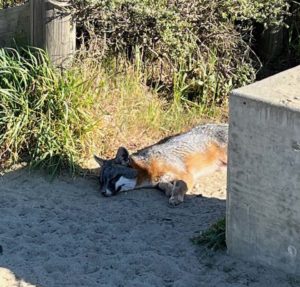The numbers are in for southern Marin’s first annual youth Christmas Bird Count (CBC). On January 8, 2011, 20 kids, 16 adults, and five expert birders bundled up against the early morning chill and headed into the field, armed with binoculars and spotting scopes. Bahia Vista Elementary, in the heart of San Rafael’s Canal District, served as headquarters for the event.
The Youth CBC followed on the heels of the official Christmas Bird Count, an annual tradition that avid birders anticipate almost as much as kids look forward to Santa Claus. The CBC represents the longest unbroken bird survey in the world.
Over 100 years later, the CBC is alive and well. This year, 120 observers took to the field in southern Marin alone, tallying 175 species and thousands of birds. And the survey has proved to be more than just a pleasant pastime. As the annual snapshots accrued, they began revealing migration patterns and trends for individual species, including declines.
Though the CBC allows the general public to participate in a valuable data-gathering effort, it tends to attract mostly serious birders. The hours are long. Participants must follow strict protocol, stick to their transects, and above all, work quietly.
In other words, the CBC is not exactly “kid-friendly,” says Wendy Dalia, education director for the Richardson Bay Audubon Center and Sanctuary (RBAC). She helped coordinate the Youth CBC, along with Andrew Frostholm, an Americorps intern with the Conservation Corps North Bay. Cosponsoring the event were Juan-Carlos Solis of WildCare and Missy Wipf of the Point Reyes Bird Observatory (PRBO).
Tom Rusert of Sonoma Birding organized the first “CBC for Kids” for Sonoma County in early 2008, and Dalia liked the notion of offering a youth-centric alternative to the CBC, something that would introduce kids to birding and allow them to participate in “citizen science” without getting too hung up on the numbers. She also wanted to reach underserved populations that don’t always see the relevance of conservation to their own lives.
The junior birders hailed from San Rafael, Ross, Mill Valley, and Tiburon, and included Canal District residents and a troop of Girl Scouts. Some came with parents and younger siblings in tow.
The kids participated in every phase of the count. After a Binoculars Boot Camp, volunteers divided them into five teams, two led entirely in Spanish. Each team followed a different route, covering an area that included the residential neighborhoods near Bahia Vista and the open space of Pickleweed Park, comprising uplands, marshy habitat, and shoreline.
“People think you have to drive to get to nature,” Dalia says. She hopes that through events like these, people realize they can connect with the environment–and the creatures in it–without having to get in their cars.
“We want them to realize that nature exists in their own backyards,” says Frostholm. Kids took turn observing, identifying and counting species and entering observations on data sheets.
A few of the families live a stone’s throw from the marsh in Pickleweed Park yet had never even taken a walk there. “They were just so excited about every bird they saw,” says Dalia. “People think it’s a degraded area, but it’s actually quite welcoming.”
That goes for both people and birds. In an hour and a half, the five teams counted 574 birds and nearly 50 different species.
After finishing their counts, the teams gathered back at the school, warmed up with snacks and cider and shared their observations. Among the highlights were a clapper rail and a small number of western bluebirds that had apparently arrived for spring unusually early. Others named Anna’s hummingbirds, American avocets, common goldeneyes, and buffleheads.
But the day’s work wasn’t over yet. Volunteers helped the kids enter their observations onto eBird, an online database where anyone from weekend birder to professional ornithologist can submit observations.
Dalia is already looking ahead to the second annual Youth CBC. She hopes that in 2012 the event will expand throughout Marin County and beyond. There is one change she would make. She originally designed the event for third through eighth-graders, but after watching kids as young as five years old actively participate, she doesn’t think the age restriction is necessary.
Dalia acknowledges the challenge of trying to lure kids away from Facebook and video screens and out into the field. But once they succeed in doing that, she predicts, the birds will do the rest.

.jpg)



